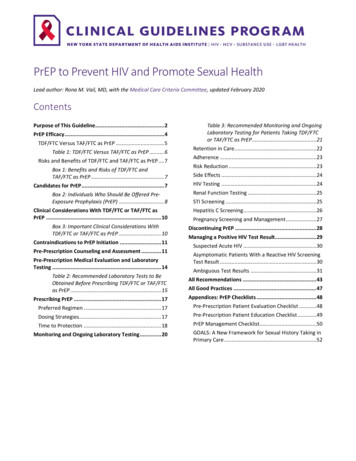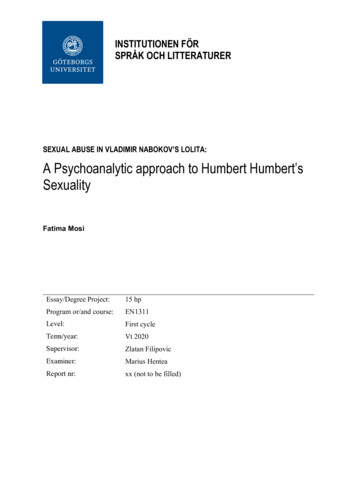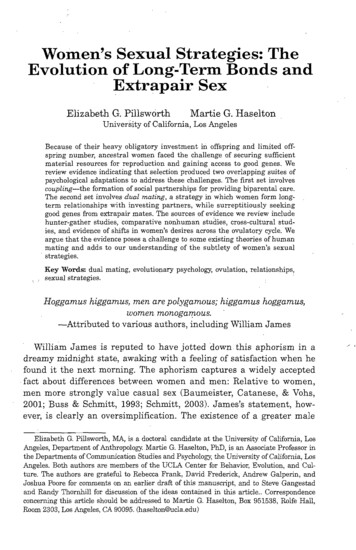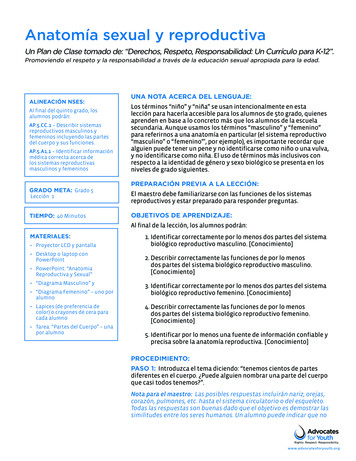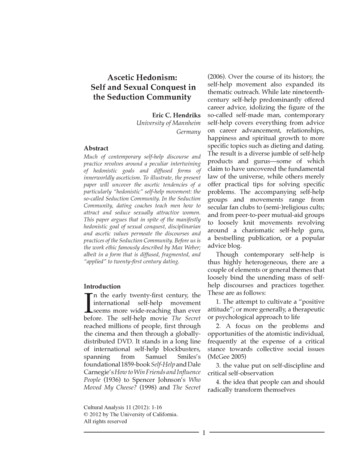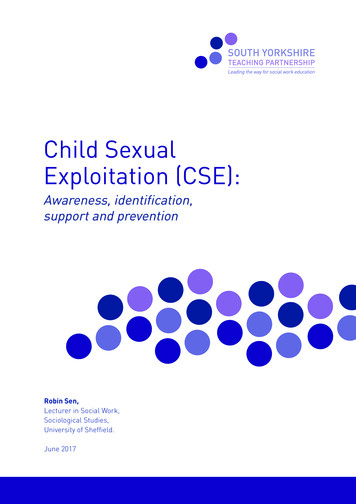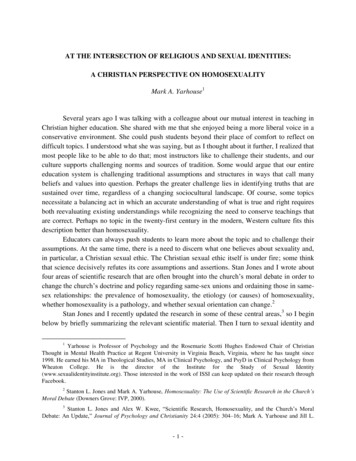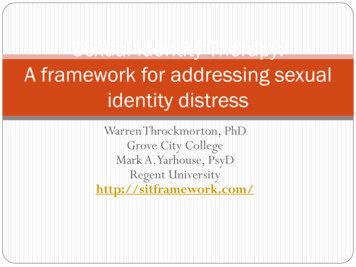
Transcription
Sexual Identity Therapy:A framework for addressing sexualidentity distressWarren Throckmorton, PhDGrove City CollegeMark A.Yarhouse, PsyDRegent Universityhttp://sitframework.com/
SIT Frameworkin the APATask ForceReport
Part One, APA ReportSOCEdefended
Part Two, APA ReportSITFramework
More Part 2,APA Report
Wall Street Journal – 8/9/09
WSJ – 8/9/09 For many years, Dr. Throckmorton felt he was breaking aprofessional taboo by telling his clients they could constructsatisfying lives by, in effect, shunting their sexuality to theside, even if that meant living celibately. That ran against thetrend in counseling toward "gay affirming" therapy -encouraging clients to embrace their sexuality. But in a striking departure, the American PsychologicalAssociation said Wednesday that it is ethical -- and can bebeneficial -- for counselors to help some clients reject gay orlesbian attractions.
New YorkTimesMagazine6/16/11
NYT Mag 6/16/11 “Many theorists in the gay-affirming world have taken a viewthat religion is a changeable aspect of personality,”Throckmorton said. “But people don‟t wake up in themorning and say, „I‟ll be a Baptist instead of a Buddhist.‟Religion is the way the world makes sense to them, and forthem that seems like a pretty stable attribute.” Rob expected to begin a process akin to psychoanalysis, butwithin just a few sessions the two were focused on the lifeRob imagined for himself. “My faith was very important tome,” he recalled. “I didn‟t want to be alone all my life, and Iwanted to be married and share that kind of life withsomeone else in the context of my Christian faith.”
NYT Mag 6/16/11 In the final document.The A.P.A. considered the kind of identitytherapy proposed by Throckmorton and Yarhouse to be a viableoption. No effort needed to be expended trying to change aclient‟s religion or sexual orientation. Therapy, in fact, was to haveno particular outcome either way, other than to guide the clientcloser to self-acceptance, whatever the client believed that to be. Clinton Anderson, director of the A.P.A.‟s Lesbian, Gay, Bisexualand Transgender Concerns Office, put it another way: “The taskforce report is more of an acknowledgment than was true in thepast that not everyone who is coming to this dilemma with astrong religious background is going to find an adaptation that ispositive with regard to their sexuality. There may be people whoare just not going to get there.”
NYT Mag 6/16/11 It [the 2009 APA report] further stated thatacting on same-sex attractions might not bea fulfilling solution for everyone. “I called upMark, and I said: „Can you believe this? Am Ireading this right?‟ ” Throckmorton told me.
Sexual Identity Therapy Sexual identity therapy assists clients to clarify values andbeliefs about sexuality and develop an integrated sense ofself.
When values and sexuality collide Historically, there were guidelines for addressing gay, lesbianand bisexual concerns and There were (fewer) guidelines for addressing religiousconcerns in therapy How can both concerns be addressed?
When values and sexuality collide When we wrote the SIT Framework, we could find noformal guidance for persons who experience value conflictsover sexual orientation The field had polarized into gay affirming and reparativetherapy camps We took issue with both sides on several issues and wantedanother way
Why Sexual Identity TherapyFramework? (2006)The purposes of these guidelines are To develop professional consensus around best practices for peoplewho seek counseling due to value conflicts over sexual orientation. With clients, to promote the development of a valued sexual identitythat promotes personal well being and integration with other aspectsof personal identity (cultural, ethnic, relational, spiritual, worldview,etc.). To focus therapists on helping the total person – therapists shouldaddress any mental health issues that might impact the successfulresolution of a valued sexual identity. To encourage therapists to only work within their training andexpertise and make appropriate referrals. To help prospective consumers choose care that fits their individualneeds
APA Task Force Report (2009) Telic congruence (i.e.,living consistently within one‟s valuative goals Organismic congruence (i.e., living with a sense of wholeness inone‟sexperiential self This difference in worldviews can impact psychotherapy. For instance,individuals who have strong religious beliefs can experience tensionsand conflicts between their ideal self and beliefs and their sexual andaffectional needs and desires The different worldviews would approach psychotherapy for theseindividuals from dissimilar perspectives: The telic strategy wouldprioritize values, whereas the organismic approach would give priorityto the development of self-awareness and identity It is important to note that the organismic worldview can becongruent withand respectful of religion (Beckstead & Israel, 2007)and the telic worldview can be aware of sexual stigma and respectful ofsexual orientation (Throckmorton & Yarhouse, 2006).
Definitions Sexual identity – A person‟s assessment of erotic orientation,emotional/romantic preferences, inclinations to engage insexual activities and social behavior. Sexual orientation - It depends. Some define as attractions,some as behavior, some as identity and some as all three. Wetend to view it as erotic preferences.
What is sexual identity distress? Sexual Disorder Not Otherwise Specified (302.9)includes this description: “Persistent and marked distressabout sexual orientation,” V62.89 (DSM-IV) addresses identity and religiousconflicts that may include sexual identity. Conflicts involving personal values and beliefs Conflicts involving discordance aspects of relationshipand attachment orientation
When values andsexuality collide We propose the sexual identity therapy as aframework to guide services with clientswho experience value conflicts over sexualorientation.
Endorsements I have reviewed the sexual identity framework written byWarren Throckmorton and Mark Yarhouse. This frameworkprovides a very necessary outline to help therapists addressthe important concerns of clients who are in conflict overtheir homosexual attractions. The work of Drs.Throckmorton and Yarhouse transcend polarized debatesabout whether gays can change their sexual orientation.Rather, this framework helps therapists work with clients tocraft solutions tailored to their individual situations andpersonal beliefs and values. I support this framework andhope it is widely implemented. - Robert L. Spitzer, pastChairman of the committee that developed the Diagnostic andStatistical Manual of Mental and Emotional Disorders, 3rd Editionand 3rd Edition (Revised)
Endorsements "Drs. Throckmorton and Yarhouse have brilliantlyresolved contention in psychotherapy by providing thefield with unbiased guidelines that are responsive toscientific evidence, are sensitive to professional practice,and which restore patient determination in choosinghis/her goals in psychotherapy." – Dr. Nicholas Cummings,past-president of the American Psychological Association
Sexual Identity Therapy Framework Framework for conducting therapy to relieve sexualidentity distress Not a new theory of homosexuality or therapy Can incorporate many theoretical approaches Provides ethical guidelines for therapy
SIT - Four phases Assessment Advance Informed Consent Psychotherapy Sexual identity social integration
Assessment Mental health assessment Values and beliefs assessment Sexuality assessment History of the conflict
Advanced Informed Consent This should include accurate information about:Research about same-sex attraction,Possible causes of sexual orientation distress,Professional interventions available (includingsuccess rates and definitions of success),Alternatives to therapy, andPossible benefits and risks of pursuing therapy.
Advanced Informed Consent:Accurate information Mental health professional organizations do not consider homosexuality to be a mental disorderHomosexuality not the same for everyone – multiplepathways to sexual orientationNo consensus regarding causes and development ofsexualityBiological factors have some support as do someenvironmental factorsA broad range of mental health outcomes exist forhomosexuals in the same manner as for heterosexuals.
Psychotherapy May not be needed if the information providedduring the first two phases is enough Objectives and plan of psychotherapy isindividualized Sexual identity therapy provides a framework forthe application of many approaches Primary therapist stance is the reduction ofdistress and the development of plan to achievevalued action
Sexual identity integrationTherapist assists clients to: Develop strategies that support anintegration of sexual identity withpersonality Clarify values and beliefs and pattern ofsexuality Reassess strategies and direction as needed
Referral Therapist may refer if value position conflicts with client‟sdirection Client should always feel the freedom to choose anotherapproach and/or direction Increasingly controversial, especially in ACA
Practical evaluation Addresses ethically deficient approaches – e.g., we reject “holding therapy”Addresses gaps in research – e.g., lack of consensus oversexual orientationAvoids focus on change in sexual attractions as measure ofsuccessElevates values and beliefs as organizing principle of identityformationFocus is on client satisfaction as outcome measure
Things you shouldn’t hear insexual identity therapyTo heal homosexuality everyone must relive past woundsYou need to receive healthy touch in therapy in order to changeHomosexuality is a gender identity disorderYou were born gay and you should not try to resist itExperts agree that people are gay because .Anyone can completely be free of homosexual attractions if they aremotivated You are not trusting God enough if you have same sex attractions Coming out of the closet and living an openly gay life is the only wayto be really well-adjusted Your religion is homophobic, you should consider changing yourchurch
Sexual Identity Therapy:Web Links www.sitframework.com www.wthrockmorton.com www.sexualidentityinstitute.org
APA Task Force Report (2009) Telic congruence (i.e.,living consistently within one‟s valuative goals Organismic congruence (i.e., living with a sense of wholeness inone‟s experiential self This difference in worldviews can impact psychotherapy.For instance, individuals who have strong religious beliefs can experience tensions and conflicts between their ideal self and beliefs and their .



